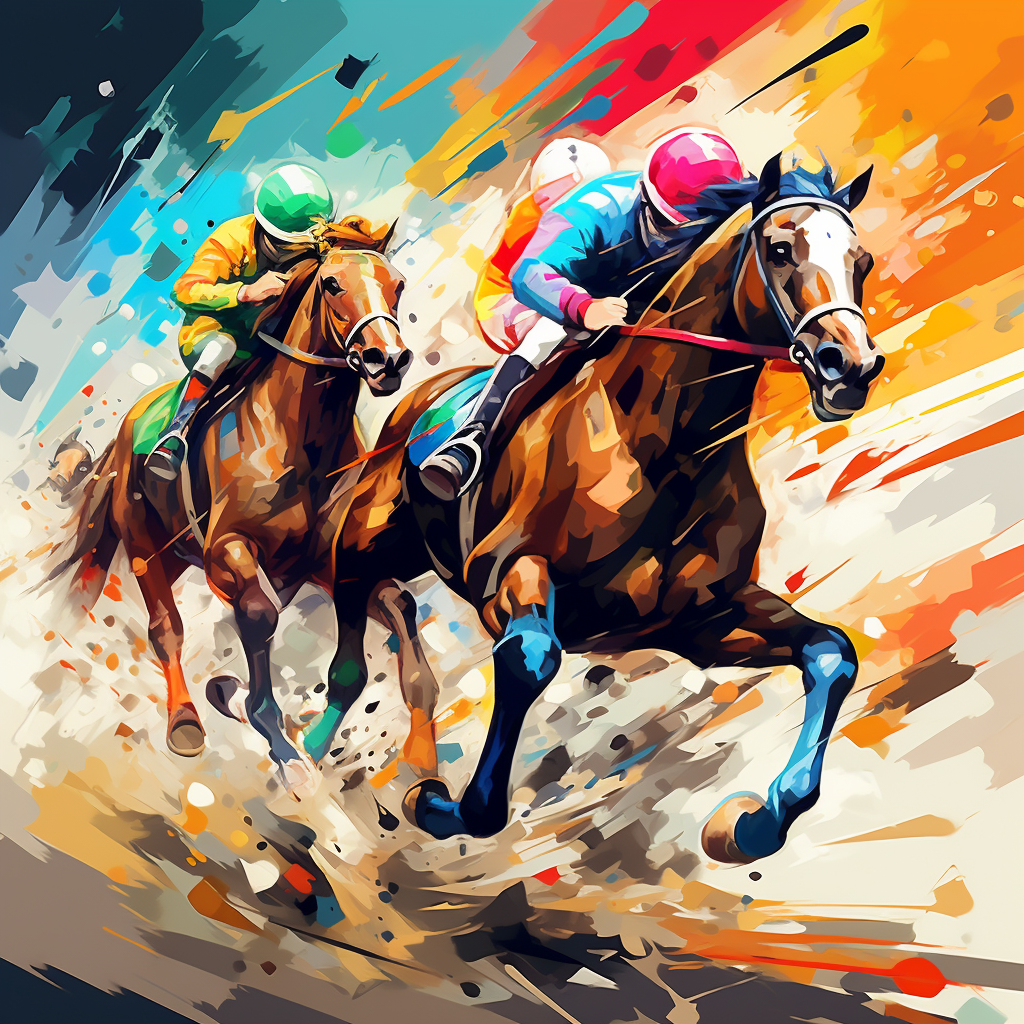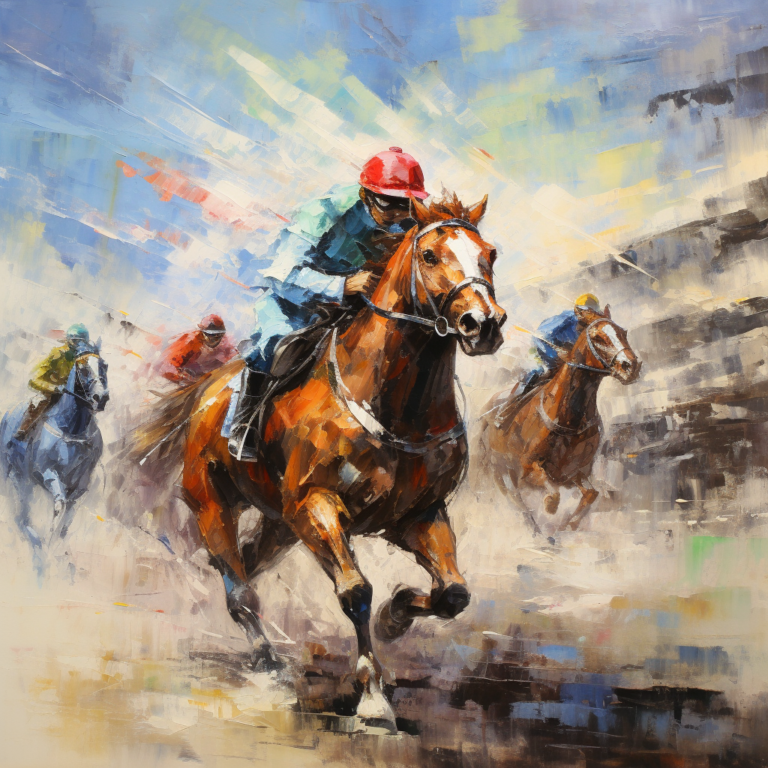Basic principles and fundamentals for anyone interested in learning about betting on horse races.

My post From my earliest memories, horse racing has captivated me, ever since those cherished days when my father took me to Oaklawn Race Track. Though I never once saw him place a bet, he was a familiar face among the stables, often found deep in conversation with trainers and jockeys. I fondly recall one morning, the mist still clinging to the track, as he discussed a horse’s lineage with a trainer whose hands told stories of a lifetime with these animals. Another vivid memory is of a jockey, wiry and vibrant, sharing insights on racing tactics before mounting a thoroughbred with a coat that shimmered like polished mahogany. And then there was the hot dog vendor, a regular at the track, who, between serving up his wares, would divulge his ‘surefire’ tips to anyone within earshot, his broad smile a fixture of my racetrack excursions. To me, the racetrack has always been a grand equalizer, a place where the thrill of the race unites people from every walk of life in the shared dream of a triumphant win.
Introduction to Horse Racing
Horse racing, often referred to as the “Sport of Kings,” holds a prestigious place in the annals of sporting history. This equestrian sport has a rich heritage that stretches back to ancient times. It’s believed to have originated in Central Asia, with records of horse racing found in the ancient Greek Olympics by 648 BC. Over centuries, this sport evolved, spreading across civilizations from Ancient Rome to the Arab world, eventually reaching medieval Europe.
The modern form of horse racing began to take shape in the 17th and 18th centuries in the United Kingdom. It was during this period that horse racing became more structured, with the establishment of racing clubs, standardized rules, and dedicated racecourses. This era marked the birth of thoroughbred racing, a breed known for its exceptional speed and stamina, specifically bred for the race track.
In contemporary times, horse racing is not just a sport but a significant cultural phenomenon. It’s a blend of tradition, excitement, and elegance. Major racing events, such as the Kentucky Derby in the United States, the Royal Ascot in the UK, and the Melbourne Cup in Australia, are not only sporting spectacles but also social gatherings, showcasing fashion and prestige.
The allure of horse racing lies not just in the thrill of the race, but also in its complexity and the skill involved. Jockeys train for years to understand and synergize with their equine partners, while trainers apply a mix of science and experience to prepare the horses. Spectators and bettors appreciate not just the race itself but the rich history and strategy behind this time-honored sport.
As horse racing continues to evolve, it retains its historical charm, marrying tradition with modernity. It’s this unique blend that continues to attract enthusiasts and spectators, making horse racing a timeless sport.
Horse racing, a multifaceted sport, encompasses various types of races, each with unique characteristics and challenges. Understanding these differences is crucial for both enthusiasts and bettors.
-
Flat Racing: This is the most common form of horse racing worldwide. Conducted on flat, level tracks, it tests the speed and stamina of the horses. Distances can vary, ranging from sprint races (typically around 5-6 furlongs) to longer routes (up to 2 miles or more). Prestigious flat races include the Kentucky Derby in the USA and the Epsom Derby in the UK.
-
Jump Racing (National Hunt Racing): Predominantly popular in the UK and Ireland, jump racing involves horses racing over obstacles. There are two main types: steeplechases, featuring larger fences and ditches, and hurdles, with smaller, more uniform obstacles. The Grand National, a steeplechase held annually in the UK, is a notable example.
-
Harness Racing: In this variation, horses race at a specific gait, either trotting or pacing. They pull a two-wheeled cart called a sulky, where the driver sits. This type of racing is particularly popular in the United States, Canada, Australia, and parts of Europe. The Hambletonian Stakes in the USA is a prominent harness racing event.
-
Endurance Racing: This tests a horse’s endurance over extremely long distances, often through challenging terrain. Races can cover 50 to 100 miles in a single day. The Tevis Cup in the USA and the Mongol Derby, which covers 1,000 kilometers across Mongolia, are well-known endurance races.
-
Quarter Horse Racing: Originating in the USA, this type of racing features American Quarter Horses, known for their explosive speed over short distances. Races are typically a quarter of a mile, emphasizing quick acceleration and agility.
Each type of race brings its own excitement and requires different skills and strategies from both the horses and their handlers. While flat racing showcases speed and grace, jump and endurance racing test agility, stamina, and the ability to navigate diverse terrains and obstacles. Harness racing highlights a different kind of discipline with its specific gait requirements. The diversity within horse racing not only adds to its appeal but also offers various avenues for betting and participation.

Understanding Horse Racing Terminology
Navigating the world of horse racing can be daunting for newcomers, partly due to its specialized vocabulary. Understanding this terminology is key to appreciating the sport and making informed betting decisions.
1. Furlong: A traditional measure of distance in horse racing. One furlong equals one-eighth of a mile or 220 yards. Race distances are often quoted in furlongs, especially in the UK and Ireland.
2. Maiden Race: These races are for horses that have never won a race. They help in determining a horse’s capability and potential before moving on to more competitive events.
3. Handicap Race: A race where horses carry different weights to level the playing field. Weights are assigned based on past performance, with better horses carrying more weight. This system creates a more competitive and unpredictable race.
4. Stakes Race: These are top-level races with higher prize money. Horses entered in these races are usually of higher quality and often have an entry fee. Examples include the Triple Crown races in the United States.
5. Racing Form: A vital tool for bettors, the racing form provides detailed information about the horses’ past performances. It includes data on recent races, win-loss records, training, and jockey details.
6. Silks: These are the distinctive jackets and caps worn by jockeys. Each set of silks is unique to an owner or trainer and helps spectators and bettors identify the horses during a race.
7. Starting Gate: The mechanical barrier from which horses start a flat race. Its purpose is to ensure a fair and simultaneous start for all horses.
8. Photo Finish: When a race is too close to call by eye, a photo finish is used. A camera positioned at the finish line captures the precise moment each horse crosses, determining the winner in a tight race.
Understanding these terms helps enthusiasts gain deeper insight into the intricacies of horse racing. It’s a sport where every detail matters, from the horse’s lineage and training to the conditions on the race day. Mastery of this language not only enhances the experience of watching a race but is also crucial for those looking to partake in betting, allowing for a more strategic and informed approach.
An Overview of Betting on Horse Races
Betting on horse races is an integral part of the racing experience, combining skill, knowledge, and a bit of luck. For beginners, understanding the basic betting formats and how odds work is essential to enjoy this aspect of the sport.
Types of Bets:
-
Win: You bet on a horse to finish first.
-
Place: Your horse must finish either first or second.
-
Show: A bet where your horse needs to finish in the top three.
-
Exacta: You pick the first two finishers in the exact order.
-
Trifecta: Similar to an exacta, but for the first three horses in the correct order.
-
Superfecta: A bet on the first four finishers in precise order.
Understanding Odds:
-
Odds in horse racing reflect the likelihood of a horse winning. For example, 5 to 1 odds means that for every $1 wagered, you’ll win $5 if your horse comes in first.
-
Odds also indicate a horse’s perceived chances; lower odds mean a higher chance of winning but smaller payouts.
How to Place a Bet:
-
Bets can be placed at the race track, in betting shops, or increasingly, online through various platforms.
-
When placing a bet, you need to state the race number, bet amount, type of bet, and the horse’s number.
Reading the Racing Form:
-
A crucial skill in betting is interpreting the racing form. It provides detailed information on horses’ past performances, helping bettors make informed decisions.
Factors Influencing Betting:
-
Besides the horse’s history, factors like the jockey’s skill, the trainer’s record, track conditions, and the horse’s position in the starting gate can influence the outcome.
Betting Strategies:
-
Experienced bettors often use strategies like hedging bets across multiple races or focusing on either favorites or long shots based on trends and statistics.
-
Betting on horse races is not just about luck; it involves analyzing data, understanding the sport, and making calculated decisions. While there’s no guaranteed formula for success, gaining knowledge and experience over time can significantly enhance your betting strategy and enjoyment of the sport.
Strategies for Successful Betting
Successful betting in horse racing isn’t solely reliant on luck; it requires a blend of strategy, knowledge, and disciplined decision-making. Here are some key strategies and tips that can help bettors make more informed choices:
-
Analyzing Horse and Jockey Track Records:
Past performance is a significant predictor in horse racing. Reviewing a horse’s recent race results, its performance on different track types, and its response to varying distances can provide valuable insights.The jockey’s experience and success rate are also crucial. A skilled jockey paired with a well-performing horse can significantly impact the race outcome.
-
Understanding Race Conditions:
Track conditions, such as turf versus dirt and wet or dry surfaces, can greatly affect a race. Some horses perform better on specific surfaces.Weather conditions on the race day can also influence the outcome. It’s important to know how each horse performs under varying weather conditions.
-
Formulating a Betting Strategy:
Setting a budget and sticking to it is vital to ensure responsible betting.Diversifying bets across different types of wagers can increase chances of winning. For instance, combining safer bets (like show bets) with riskier, higher-payout bets (like trifectas) can balance risk and reward.
-
Learning from the Experts:
Following tipsters and experts can provide insights, but it’s important to use this information judiciously. Combine expert advice with personal research to make informed bets.
-
Staying Updated and Informed:
Keeping abreast of the latest news in horse racing, such as any last-minute changes in the lineup, withdrawals, or any other pertinent information, can be crucial.
-
Avoiding Common Pitfalls:
Avoid emotional betting, such as betting on a favorite horse regardless of its chances. Decisions should be based on data and analysis rather than sentiment.
-
Record Keeping:
Keeping a record of bets, outcomes, and strategies can help in identifying what works and what doesn’t, refining betting strategies over time.
By employing these strategies, bettors can enhance their understanding of horse racing and improve their chances of successful betting. It’s a continuous learning process, where each race offers new data and opportunities to refine one’s approach.
Specific Betting Strategies
Dutching Betting:
-
Dutching involves betting on multiple horses in a race to increase the chances of winning. The idea is to divide your stake in a way that ensures the same profit if any of your bets win.
-
To apply this strategy, a bettor calculates the amount to wager on each horse, considering their odds, so that the return is the same regardless of which horse wins. This method requires good odds calculation skills and an understanding of value betting.
Laying the Favorite:
-
This strategy is often used in betting exchanges where you can bet against a horse (laying a bet). The principle is to look for races where the favorite (the horse with the lowest odds, and therefore seen as most likely to win) seems overvalued or has conditions against it.
-
The bettor then places a lay bet against this horse, betting that it will not win. This strategy relies on in-depth knowledge of horse racing and the ability to identify races where the favorite is less likely to perform as expected.
Value Betting:
-
Value betting is about finding bets that have higher odds than their actual winning chances. It involves identifying horses whose chances of winning are better than what the betting odds reflect.
-
To be successful with this strategy, bettors need to have a deep understanding of horse racing dynamics and be skilled in assessing horses’ performance potential beyond what is represented by the public odds. It often involves looking at underdogs or horses that might have been underestimated by the market.
Each of these strategies requires a different level of expertise and understanding of horse racing. They also come with their own risks, and like all betting strategies, none offer guaranteed returns. It’s important for bettors to approach them responsibly and with a clear understanding of the risks involved.

The Role of Technology in Horse Racing and Betting
The advent of technology has significantly transformed horse racing and betting, making it more accessible and analytical than ever before.
-
Digital Betting Platforms:
-
The rise of online betting platforms has revolutionized how bets are placed. These platforms offer convenience, a wide array of betting options, and real-time odds updates.
-
Mobile apps have further enhanced accessibility, allowing bettors to place wagers, track live races, and access data from anywhere.
-
Data Analytics and Handicapping Software:
-
Advanced software tools analyze vast amounts of data, helping bettors make more informed decisions. These tools can assess track conditions, weather, horse performance history, and more.
-
Some platforms offer predictive analytics, using algorithms to suggest potential race outcomes.
-
Race Tracking and Live Streaming:
-
GPS and RFID technology are used to track horses during a race, providing precise data on their position, speed, and distance covered.
-
Live streaming services allow fans to watch races in real-time from across the globe, making it easier to follow favorite horses, jockeys, and races.
-
Virtual Reality and Simulation:
-
Virtual reality (VR) experiences and simulations offer fans and bettors immersive ways to engage with horse racing, including virtual tours of racecourses or simulated betting experiences.
-
Social Media and Online Communities:
-
Social media platforms have fostered global communities of horse racing enthusiasts. They offer a space to share tips, discuss races, and access expert insights.
-
Online forums and platforms also provide educational resources for new bettors and fans
6.Impact on Training and Horse Welfare:
-
Technology isn’t just changing the betting aspect; it’s also impacting horse training. Wearable technology for horses allows trainers to monitor health and performance more closely.
Innovations in track and stable conditions, informed by technological advancements, contribute to improved horse welfare.
The integration of technology in horse racing and betting has created a more dynamic, accessible, and data-driven sport. While the essence of horse racing remains unchanged, technology enhances the experience for fans, bettors, and professionals alike, bridging traditional charm with modern efficiency.
Betting Apps That May Be Helpful
For horse racing enthusiasts looking for apps that analyze races and provide predictions, there are several options that employ data analysis and algorithms to offer insights and forecasts. Here are some apps known for their analytical and predictive capabilities in horse racing:
1. Timeform: Timeform is renowned for its detailed analysis of horse racing. The app provides ratings, form data, and expert opinions to help users make informed betting decisions. It also offers predictions and race analysis based on comprehensive data.
2. At The Races (ATR): This app offers detailed racecards, form analysis, and expert tips. ATR is known for its in-depth analysis of UK and Irish horse races, providing predictions and insights that can guide betting decisions.
3. Equibase: Equibase offers a range of tools and data for thoroughbred racing enthusiasts. Their mobile app provides handicapping products like Stats Central, which gives analytical insights and predictions based on extensive race data.
4. Horse Racing Tips App: This app focuses on providing daily racing tips and predictions from a team of experts. It analyzes races and offers selections based on thorough research and analysis.
5. Proform Racing: Known for its advanced data and statistical analysis tools, Proform Racing offers sophisticated software that provides race analysis, system building, and form study tools. The app is designed to assist serious bettors with predictions and race analysis.
6. Racing Post: While primarily a news and information resource, the Racing Post app also provides race analysis, tips, and predictions. Their predictions are based on expert opinions and comprehensive form data.
It’s important to remember that while these apps provide predictions based on data analysis, no prediction can be guaranteed accurate. They should be used as a guide and part of a broader strategy that includes your own research and understanding of horse racing. Betting should always be done responsibly and within one’s means.
Conclusion and Additional Resources
As we’ve explored the exciting and complex world of horse racing and betting, it’s evident that this sport combines rich tradition with dynamic modern elements. From understanding the different types of horse races and mastering racing terminology to formulating successful betting strategies and leveraging technology, the realm of horse racing offers a diverse and engaging experience.
Key Takeaways:
-
Horse racing is a multifaceted sport with a storied history and various race types, each requiring different skills and strategies.
-
Betting on horse races is both an art and a science, demanding knowledge, analytical skills, and responsible decision-making.
3. Texhnology plays a pivotal role in modern horse racing and betting, offering new tools for analysis, betting, and engagement.
Videos:
How to Bet on Horse Racing | Beginners Guide to Betting Horses
-
Video Link: How to Bet on Horse Racing | Beginners Guide to Betting Horses – YouTube
-
This video serves as an introduction to horse race betting, providing a comprehensive guide for beginners. It c covers the basics of how to place bets in horse racing and is part of the Sports Betting 101 series by WagerTalk TV.
Horse Race Betting Strategy | Sports Betting on Horse Races for Beginners | A Tutorial
-
Video Link: Horse Race Betting Strategy | Sports Betting on Horse Races … – YouTube
-
This video by OddsJam offers a tutorial on horse race betting strategy, specifically designed for beginners. It’s a good resource for those new to sports betting and looking for a basic understanding of strategies in horse racing.
Horse Racing Betting Strategy Broken Down…”
-
Video Link: Horse Racing Betting Strategy Broken Down… – YouTube
-
In this video, Caan Berry Pro Trader breaks down a specific horse racing betting strategy. It is particularly useful for viewers interested in understanding the nuances of betting strategies in horse racing.
For Further Exploration:
-
Books and Literature: Numerous books delve into the history of horse racing, the nuances of betting, and strategies for success. Titles like “Betting on Horse Racing For Dummies” can be a great starting point for beginners.
-
Online Resources: Websites like Equibase and Racing Post offer extensive data on horses, jockeys, and races, along with expert analysis and tips.
-
Courses and Workshops: Consider enrolling in online courses or local workshops that cover horse racing and betting fundamentals.
-
Racecourse Visits: Nothing beats the experience of visiting a racecourse. It’s a great way to immerse oneself in the atmosphere of the sport.
Remember, the journey into horse racing and betting is ongoing. It’s a sport where history, knowledge, and continuous learning come together, offering a rich and rewarding experience. Whether you’re a casual spectator, an aspiring bettor, or just someone fascinated by the sport, there’s always something new to discover in the thrilling world of horse racing.
And remember for the best tips, talk to the hot dog man!




